ISSN ONLINE(2319-8753)PRINT(2347-6710)
ISSN ONLINE(2319-8753)PRINT(2347-6710)
S.P.Rajaram #1, V.Rajasekaran *2, V.Sivakumar#3
|
| Related article at Pubmed, Scholar Google |
Visit for more related articles at International Journal of Innovative Research in Science, Engineering and Technology
Voltage stability is an important problem in the Emerging world of technologies and development, the main objectives in operating an Electric power system is to maintain a proper voltage level thought a system. The Failure occurred in the system equipment to be damage and blackouts. This paper mainly discusses the nonlinear aspect of power systems, with emphasis on voltage instability. In that scenario modal analysis method make use of the power system Jacobean matrix to determine the eigenvalues necessary for the evaluation of the voltage stability of the power system. The least Eigen values indicate the proximity of the system to voltage instability. The voltage profile and critical loading is found by using continuation power flow method. These methods were implemented on IEEE 14 bus system result of the proposed work held on with the help of MATLAB software.
Keywords |
| Continuation Power Flow, Modal Analysis, Distributed Generation, Voltage Collapse, Power System Analysis. |
INTRODUCTION |
| The important operating tasks of power utilities are keep voltage within the operating limit. In recent year power demand is increase worldwide. A Power system is interconnected in to generating station transmission line and distribution line. The existing power system lines are being more and more pressurized. In that power system distribution networks are usually subjected to voltage instability; sometimes voltage collapses. Voltage collapse has become increasing threat to power system security and reliability. Voltage stability analysis is widely used in the planning and daily operation of the power system and online monitoring of the distribution system. Load flow techniques are widely used for voltage stability analysis [1]. |
| The modal analysis method is best method for voltage stability analysis compare to L-index method [2].Voltage stability analysis is most important factor for highly developed networks. Voltage stability is the ability of power system to maintain steady acceptable voltage at all buses in the system under normal condition [3]. |
| Voltage instability stems from the attempt of load dynamics to restore power consumption beyond the capability of the combined transmission and distribution system[3].Voltage stability problems are easily predict through the steady state analysis and load flow analysis. The voltage stability problems are mainly depends up on reactive power variation. The control of reactive power some distributed technologies are used to generate reactive power and improve voltage stability. |
| The voltage stability problems are mainly occurred at the distribution side of the power system network. In that distribution network is customer side (or) load side of the power system network [4]. |
| The distributed generation is connected at the customer side (or) load side of the power system network. The distributed generation to generate the power from near to the load .In that distributed generation connect to the power system many benefits are there we provide quality of power to the customer ,improve voltage profile, Reduce power loss, improve system reliability and efficiency [5,6]. |
| There are many methods are currently used in the voltage stability analysis, the methods are Modal analysis, Steady state voltage stability index, Newton rap son load flow analysis, L-Index method, Singular value decomposition, Line stability index, Continuation power flow method. |
| This paper Modal analysis and continuation power flow methods are used to find the voltage stability analysis. To determine the optimal allocation of distributed generation is presented. Modal analysis and continuation power flow methods are used to find the optimal allocation of distribution generation. In that modal analysis method involved in Eigen values and Eigen vectors of reduced Jacobean matrix, the modal analysis method used to identify the weakest bus by calculating the participation factor, QV-sensitivity factor and stability margin [6]. Continuation power flow method is implemented in the power system analysis Tool box. In the Continuation power flow method voltage profile and critical loading is found. The weak bus is identified based on the voltage profile |
II. VOLTAGE STABILITY PROBLEMS |
A. Problem Identification |
| Voltage stability problems are mainly occurred at distribution side and load side of the power system network. In that voltage stability problems are mainly occurred at in sufficient range of reactive power. The reactive power shortage mainly affects the voltage profile. To eliminate the reactive power shortage to increase the distributed generation technologies, distributed generation is to generate the reactive power. |
B. Modal Analysis |
| Modal analysis is a static approach it is a best tool for voltage stability analysis. In that modal analysis method can be discover the instability characteristic effectively. The the modal analysis method is used to identify the weakest bus by calculating participation factor and sensitivity factor. |
| Modal analysis ΔV/ΔQ is a powerful technique to predict voltage collapse and determine stability margin in power system. |
| By solving linearized power flow equation we get the ΔP and ΔQ matrix |
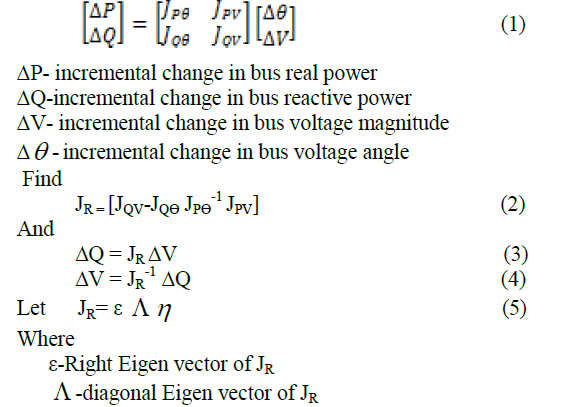 |
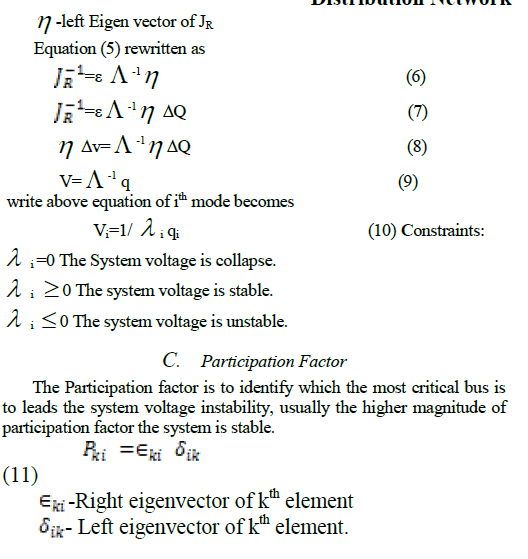 |
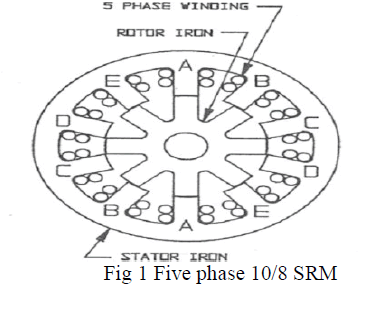 |
D. Continuation Power Flow |
| The identification of Maximum load ability limit most critical problem in voltage stability analysis. In that maximum load ability limit is does not calculate through the modal analysis. The continuation power flow method find the voltage profile up to the voltage collapse point. Voltage profile and critical loading is found weakest bus is identify based on the voltage profile .The continuation power flow method is implemented in PSAT consists of a predictor step realized by the computation of the tangent vector, initial solution and corrector step can be obtained either by means of a local parameters .Power flow equation expressed as |
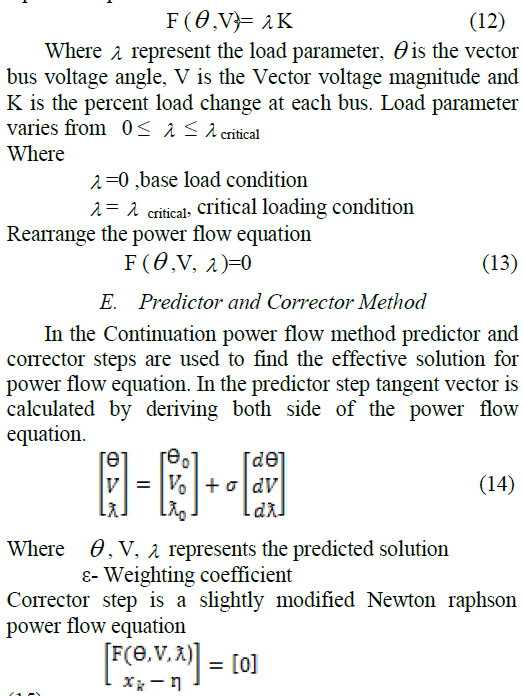 |
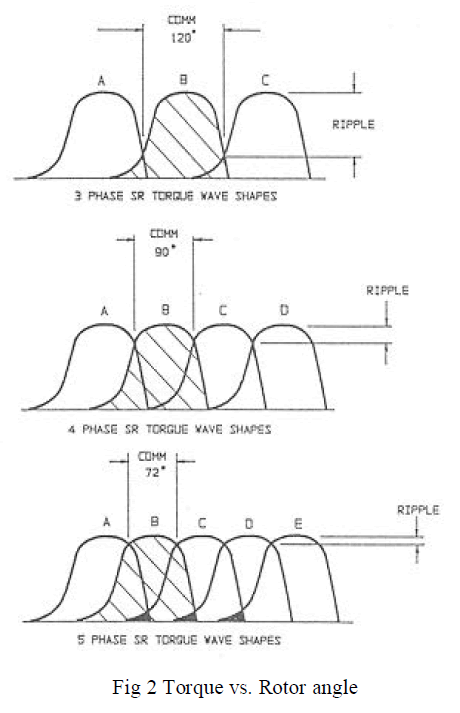 |
III. DISTRIBUTEDGENERATION |
| Distributed generation technologies is to play a major role in power system network[4], In that distributed generators connected directly to the grid. Distributed generation to generate power from load side of the power system network [6].Importance of distributed generation is to improve reliability, security, efficiency and quality of the power system. |
A. Distributed Generation Placement |
| The distributed generation placement in distribution network to improve the voltage profile reduces losses, improve reliability. In this paper we use continuation power flow can be used to find the voltage stability margin, based on the stability margin to find the collapse point of the distribution network, the modal analysis method to determine the critical modes of the distribution network. This voltage collapse and critical mode a bus is selected candidate for distributed generation placement. The CPF method highest voltage magnitude buses is selected candidate for DG placement and modal analysis method highest Eigen value, biggest participation factor and less stability margin in each mode is selected candidate for DG placement. |
IV. RESULT AND DISCUSSION |
A. Modal Analysis IEEE 14 Bus System |
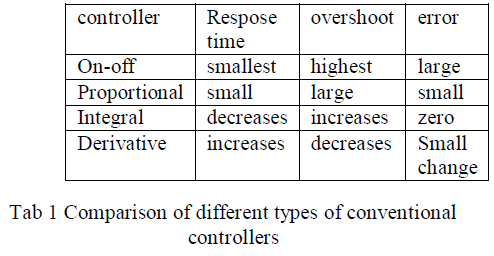 |
| From the above table bus number 14, 10, and 9 have the highest participation factor for the critical mode. In the three buses bus 14 is a highest participation factor (0.3264).so bus no 14 indicates the highest contribution to voltage collapse. |
B. Modal Analysis IEEE 14 bus system output |
| The load voltage vs. apparent power graph is drawn for all buses in IEEE -14 bus system at zero power factor value. In that 14 system bus no 14 is least stable compared |
C. Continuation Power Flow IEEE 14 Bus System Using PSAT |
| The CPF method critical loading and voltage profile is found. The weak bus is identified based on the voltage profile. The weak bus is considered as the optimal location to place a distributed generator to all other buses. |
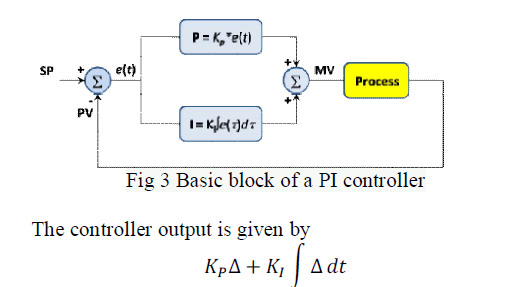 |
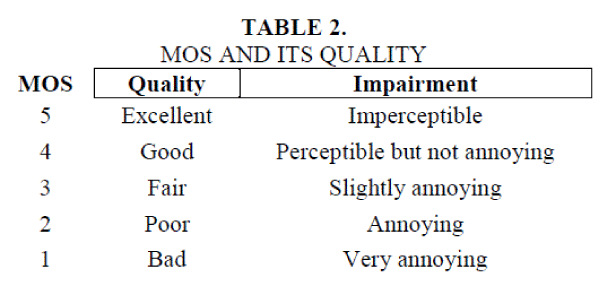 |
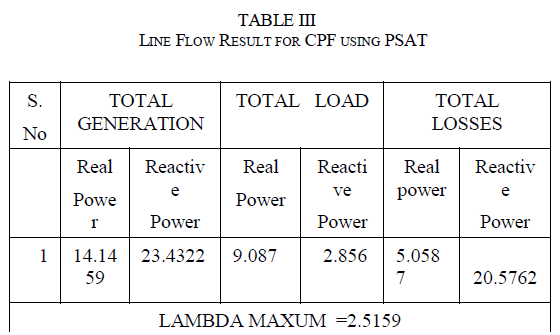 |
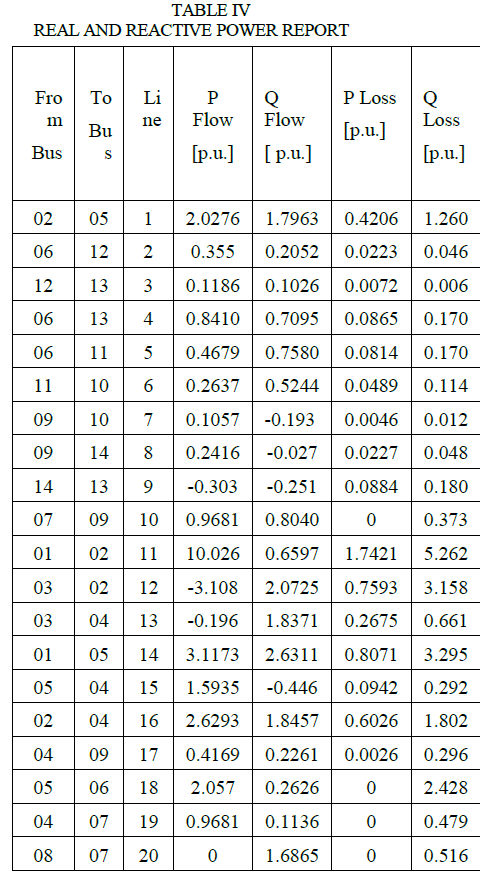 |
| The Continuation power flow method voltage profile and critical loading is found ( λmax=2.5159). The weak bus is identified based on the voltage profile. |
| The Continuation power flow method bus number 14, 10, and 9 are critical bus in the IEEE 14 bus system. In the three buses bus no 14 is the most critical bus (0.54847).so bus no 14 indicates the highest contribution to voltage collapse. |
D. Voltage Magnitude of IEEE 14 bus system by using CPF |
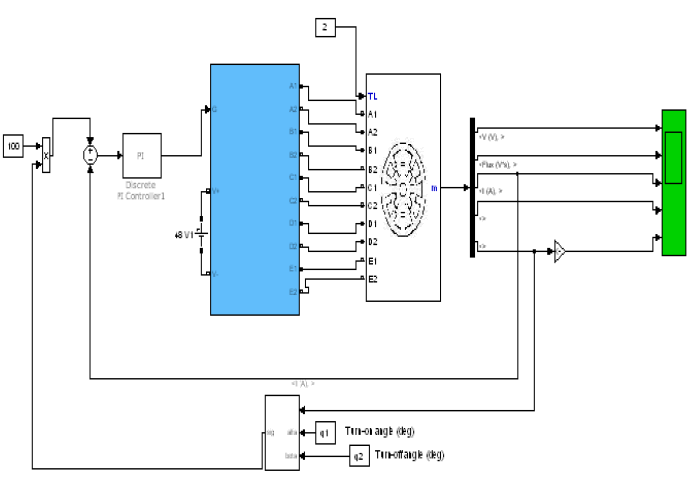 |
| Fig. 4 Voltage magnitude for IEEE 14 bus system |
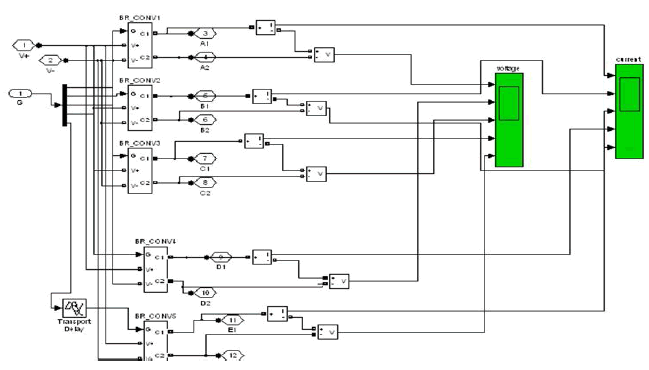 |
V. CONCLUSION |
| In this paper, Modal analysis and Continuation Power Flow method is used to voltage stability analysis of power system is presented. The voltage collapse problem is studied by using above two methods. Modal analysis technique, 14,10,9 buses are found to be the weakest and contributing to voltage collapse in IEEE 14 bus system. The stability margin or the distance to voltage collapse is identified based on voltage and reactive power variation. The Continuation power flow method voltage profile and critical loading is found. The weak bus is identified based on the voltage profile. In the continuation power flow method 14,10,9 buses are found to be the most critical and contributing to voltage collapse in IEEE 14 bus system. |
References |
|